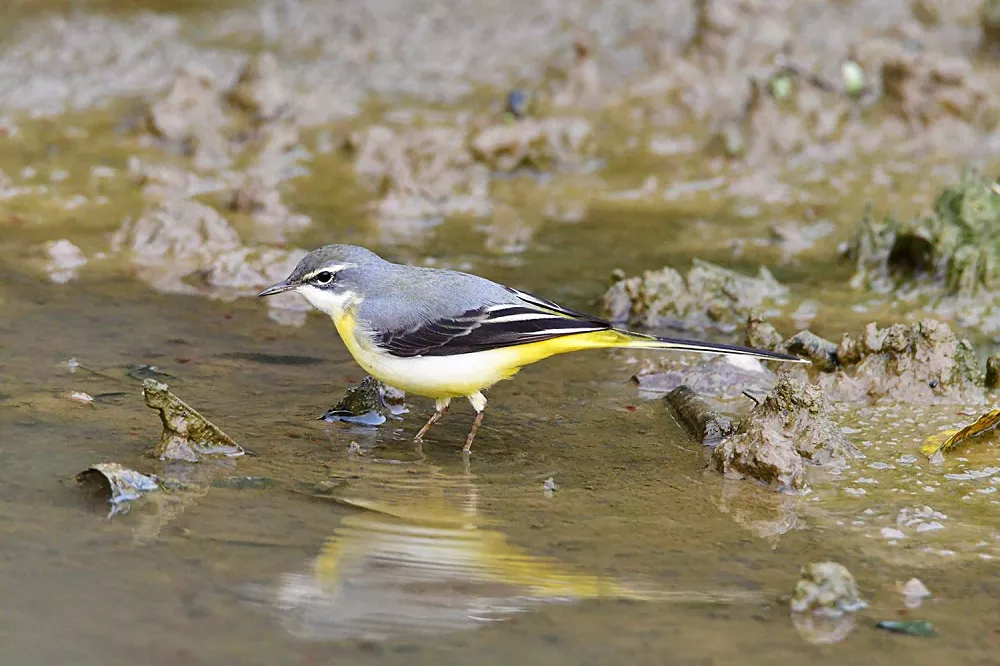The grey wagtail (Motacilla cinerea) is a member of the wagtail family, Motacillidae, small and medium-sized songbirds, measuring around 18–19 cm overall length. The species looks somewhat similar to the yellow wagtail but has the yellow on its underside restrictive to the throat and vent. Breeding males have a black throat.
What does a grey wagtail look like
The grey wagtail male has a grey or dark grey forehead, top of the head, pillow and nape of the neck; shoulders, back, and waist grey with dark greenish brown or dark taupe. The overlying feathers of the tail are bright yellow, partially stained with brown, the central tail feathers are black or dark brown, with yellow-green feather margins, the outer 3 pairs of tail feathers are all white except the first pair, the second and third outer feathers are black or mostly black, and the inner tail feathers are black or mostly black. Pai white. The two wing coverts and flight feathers are dark brown, except for the first, second and third outer primary flight feathers, the other primary flight feathers have white feather edges inside, and the base of the secondary flight feathers is white, forming an obvious white wing spot. The flight feathers have a broad white or yellow-white feather margin. Eyebrow and cheek lines are white, eyes and ear feathers are grey-black. The chin and throat are black in summer and white in winter, and the rest of the lower body is bright yellow. The female bird is similar to the male bird, but the upper body of the female bird is greener grey, and the chin and throat are white, not black. Iris brown, mouth dark brown or black, tarsus and toes dark green or horn brown.
Grey wagtail habitat
The grey wagtail mainly inhabits streams, valleys, lakes, ponds, swamps and other waters or grasslands, farmlands, houses and forest settlements near the waters. It especially likes to move on the banks of mountain rivers and roads. Among forest streams and city parks. Altitude ranges from plain grasslands at an altitude of 2,000 meters to alpine wilderness wetlands above 2,000 meters. In the north of the Yangtze River in China, there are mainly summer migratory birds and some traveling birds; in the south of the Yangtze River, there are mainly winter migratory birds and some traveling birds. Every year, they begin to move to the north at the end of March and the beginning of April.
Grey wagtail living habit
The grey wagtail is often found alone or in pairs, sometimes in small flocks or mixed with white wagtails. When flying, the two wings are stretched and retracted, advancing in waves, and continuously making chirping sounds. It often perches on protruding objects such as watersides, rocks, utility poles, roofs, etc., and sometimes perches on the top branches of small trees and stones exposed in the water, with its tail constantly swinging up and down. After being disturbed, it flies up and down along the river valley, and keeps singing. Often walk along the river or road to hunt for prey.
What does grey wagtail eat
The grey wagtail feeds primarily on insects. Among them, the chicks mainly feed on aquatic insects such as stone moths and stoneflies, and also eat a small amount of Coleoptera insects. Adult grey wagtail mainly live in caddis worms, flies, beetles, ants, locusts, mantis, grasshoppers, bees, stinkbugs, caterpillars, etc. Coleoptera, Lepidoptera, Orthoptera, Hemiptera, Diptera, Hymenoptera Feed on insects. They also eat other small invertebrates such as spiders. It mostly walks or runs by the water’s edge to prey, and sometimes also preys in the air.
Distribution range of grey wagtail
Mainly distributed in: China, Australia, Belarus, South Korea, Japan, North Korea, the United Kingdom, Norway, Sweden, Iran, Turkey, Afghanistan and other places.


 Facebook
Facebook  Instagram
Instagram  Youtube
Youtube 